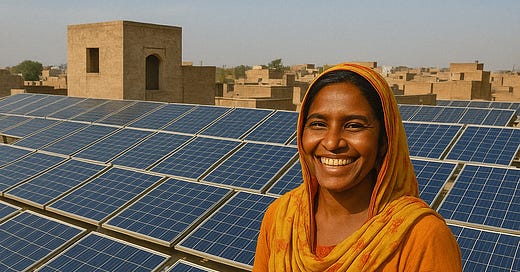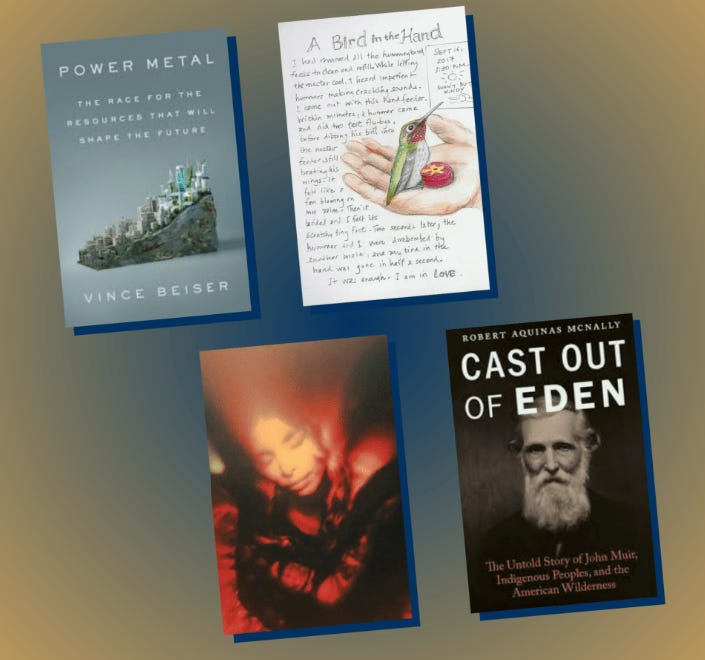You Can’t Tariff Sunshine and Wind; Handling A Million Pounds of Dangerous Batteries
And more about the human and environmental costs of renewable energy and digital technology—and how we can do better.
Happy Thursday! For the last couple of weeks I’ve been asking readers to consider upgrading to a paid subscription, and the response has been great. If you haven’t made the jump yourself, I hope you’ll think about it.
For many years I’ve made my living as a magazine freelancer, but now the news business is collapsing. Journalists have been laid off by the boatload, and once-mighty publications have shriveled or disappeared completely. I believe independent journalism can make a difference in the world. For years I’ve been able to make a living doing just that. But the old model of selling stories to established publications just doesn’t work anymore.
So instead, I’m communicating directly with you, the readers, through this newsletter. To keep it going, I hope you’ll consider upgrading to a paid subscription. The basic level is just $5 a month—less than a Starbucks croissant, and more satisfying! An even better deal: If you sign up at the Founding Member level, I’ll send you a signed copy of Power Metal, the book!
No worries if you’re not up for paying right now. You can still help by clicking the Like or Restack buttons at the bottom of this email, forwarding this newsletter to friends, or sharing it on your favorite socials. In any case, thanks for reading!
You Can’t Tariff Sunshine and Wind
If there’s one lesson to be learned from the tariff mongering and trade warring of the last few weeks, it’s this: no country can afford to depend entirely on another. That’s especially true when it comes to energy, the lifeblood of every nation’s economy. Which is why now, more than ever, countries should be investing in solar and wind power—not just to save the climate, but as a matter of national security.
All fossil fuels—oil, gas and coal—have a built-in flaw: you need to burn them to produce energy. Once you’ve burned them, they’re gone, and you need more. You have to constantly feed that fire with fresh supplies of new fuel. Most countries don’t have enough of those fuels, so they have to buy them from those that do. Among the world’s leading sellers of fossil fuels are Russia, the United States and several Middle Eastern states. None of them are places you want to put your long-term faith in.
Sunshine and wind, on the other hand, are everywhere. Sure, most countries need to import the machinery required to convert sun and wind into power, but once you’ve done that you’re pretty much all set. The costs are mostly up front, in building the installations. Once they’re up and running, with a little basic maintenance, solar and wind farms can keep producing energy for decades. They don’t require a constant stream of expensive, imported fuel, always in danger of being disrupted by mercurial trade policies or Houthi missiles.
It seems that between Putin’s invasion of Ukraine and Trump’s chaoticizing of global trade that leaders in many nations are starting to recognize those facts. “Security is now paramount. The energy transformation is on the cusp of reaccelerating,” writes an analyst at Carlyle, a colossal global investment firm. “Climate concerns, however, will not be the main driver… It will be driven by the quest for security, with nations creating a diversified energy mix of joules across multiple sources to insulate themselves (and investment portfolios) from geopolitical, macro, and financial risks.” Another analyst echoes that at Inside Climate News: “The bottom line is that the world runs on imported fossil fuels under the umbrella of the Pax Americana. As Trump destabilizes that, then people will look to their own domestic energy sources, which in most cases means renewables and electrification.”
The beauty of solar, in particular, is that it doesn’t even require wholesale buy-in from politicians or big businesses. All over the developing world, people are simply setting up their own solar panels on their rooftops and yards. Those panels provide a kind of personal energy security. Russian or Iranian oil might be embargoed, American or Qatari natural gas might shoot up in price—but the sun still shines. According to Bloomberg, the World Bank estimates that by 2030, some half a billion people could get their power from solar-powered, neighborhood-based mini-grids. Pakistan, for instance, “is witnessing one of the most unexpected clean energy success stories of the decade,” says The Independent, as millions of homes and businesses set up DIY rooftop solar panels.
It’s time to stop depending on allies that might become enemies tomorrow. Time to turn our gaze upward instead, to the sky and the sun.
How to Handle A Million Pounds of Dangerously Damaged Batteries
After the catastrophic fires in LA earlier this year, I wrote a piece about how cleanup workers were facing the daunting task of dealing with the countless lithium-ion batteries left behind in burned electric cars and electronic gadgets. Tough assignment, because when damaged by fire, those batteries can emit toxic gases, leach heavy metals into the ground, explode or even burst into flames.
According the Los Angeles Times, the job is now almost done, with workers having cleared over one million pounds of batteries from the rubble. It took some serious doing.
“Hundreds of environmental workers went to the burn zones to sift through the wreckage, house by house, block by block. The crews working on electric vehicles disconnected the voltage cables to air bags and seat belts, sawed off the tops of the cars, and flipped the vehicles over to access the battery packs underneath. Detaching the thousands of cells underneath and loading the batteries into metal drums could take up to two hours per car,” writes Laura J. Nelson.
The batteries were then trucked to disposal sites near the beach—much to the displeasure of people living nearby—and submerged for at least three days in dumpster-sized containers filled with a liquid solution made with table salt and baking soda. That discharged most of their energy, so that they could then be safely crushed in giant grinders. The ground-up debris was then hauled off to a waste disposal site in Utah. The leftover brine also had to be trucked to a specialized disposal site. Turns out “clean” energy storage can be very tough to clean up.
Book News
If you happen to be in Columbia, Missouri this very night, you’re invited to my talk at the University of Missouri’s School of Journalism! I’ll also be talking about Power Metal, the book, with The North Shore Writers Association in Vancouver on April 28, and at Seattle’s Town Hall on May 5.
Speaking of academia, thanks to the alumni magazine at my alma mater, UC Berkeley, for this nice review of Power Metal, plus some other interesting offerings from fellow Cal grads. (I recommend the music of ‘Portrait of My Heart’ by Spellling. Yes, that’s how she, um, spells it.) Big thanks also to the New York Public Library for naming Power Metal a finalist for this year’s Helen Bernstein Book Award for Excellence in Journalism. Congratulations to my fellow runners-up, and especially to the winner, Mike Hixenbaugh’s They Came for the Schools.
More News Worth Knowing
A landslide in Indonesia killed two workers at a nickel plant—the latest in a series of worker deaths in Sulawesi’s booming nickel industry. Indonesia has taken the lead in world nickel production, forcing mines in places like New Caledonia to shut down, leaving behind ghost towns.
US Military Programs Threatened by China’s Critical Metals Cutoff







Another great post. I have no doubt we’ll find ways to tax the sun and wind.
Good stuff Vince! raising the possibility that Trump might actually provoke a move to renewables....Interesting idea. i guess we'll see.